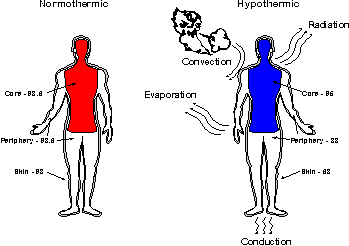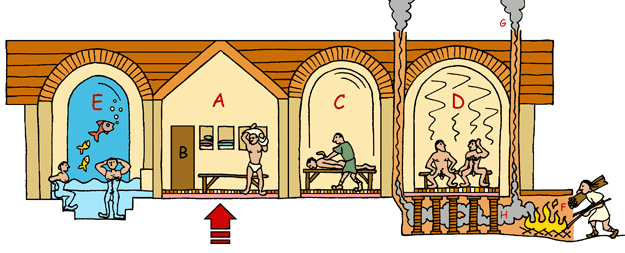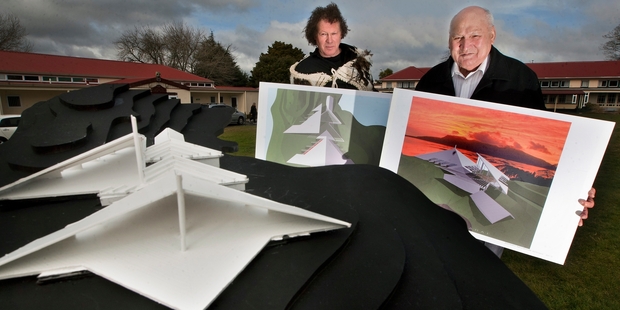 “Let it snow!”
“Let it snow!”
The Frank Lloyd Wright-designed Bachman-Wilson House.
Lots of homes new and old now have a system installed in their floors called “radiant heating,” sometimes just called “underfloor heating,” a system of heating coils in your concrete floor that keeps it warm in winter even when it’s a winter wonderland outside.
Why is it so damn good when used properly, why is it so widely misunderstood? (And who really invented it?)
To answer all that, we need to start by talking heat transfer.
As anyone who’s ever tried to heat a draughty house will know, heat likes to transfer itself from warmer to colder; and as anyone who’s ever studied physics might remember, there only three main ways by which heat can be transferred:
- by convection, i.e., by air
- by radiation , i.e., by electromagnetic waves
- by conduction, i.e., by touch
And as anyone who has ever sat in front of an open fire will know, even when hot air is going up a chimney, if you turn your face to the fire you will still feel the fire’s heat, even from some distance away.
That’s the power of radiant heat. You can feel it too from the sun – heat transferred by electromagnetic waves across the vacuum of space, making it warm enough some days to sunbathe even in winter, from a heat source millions of miles away.

How we lose heat to the environment
Now, transfer this knowledge to our own bodies, swaddled up on a winter’s night. Leaving aside sweating, i.e., evaporation (which is a nice-to-have on a cold winter’s night!) there are three ways our body loses heat.
- by convention, to colder air
- by radiation, to colder distant surfaces
- by conduction, to colder surfaces we’re touching.
Now, it’s obviously nice to have a warm floor so we don’t lose heat by conduction through our feet. But as you can see above, losing heat through our body’ peripheral parts is not our biggest heating problem (depending of course on which peripheral parts we’re talking about!). Mostly, we need to avoid losing excessive heat from our body’s core. And it turns out that we lose just over a third of our body’s heat by convection, lost to cold air, yet we lose nearly two-thirds of our body heat by radiation to colder surfaces.
That’s important.
So if heating people is not so much about keeping people warm, as stopping them cooling down – which it is -- then, paradoxically, we arrive at the conclusion that the very best way to warm someone most directly is to warm the surfaces around them.
Funny stuff, eh.
Do that right and we can create beautiful open spaces that feel perfectly comfortable to be inside in all weather, and we needn’t feel stuffy even in winter.
Got that? Because here’s the greatest misunderstanding that many people harbour about radiant heating: that you’re heating your floor in order to heat your air. That couldn’t be more wrong. You’re heating your floor to stop the people within losing their body heat to cold surfaces. Try using your floors to heat the air instead and you’ll still be as stuffy as buggery, and your power bills will start getting the extreme attention of your bank manager.
Because all these systems need to do is minimise the difference between the floor and our body temperature, which means radiant heat systems don’t even need to be turned up high to do their main job. Even a temperature of 18oC or so can be enough to make a room feel comfortable and, if we have heating pipes on our terraces, even melt all that snow. And because exposing skin to warmer surfaces exposes us more directly to radiation, we might even enjoy the experience in shirtsleeves.
 It also, incidentally, makes a more comfortable temperature gradient for the human body (above), without the head copping the majority of our heat!
It also, incidentally, makes a more comfortable temperature gradient for the human body (above), without the head copping the majority of our heat!
So, where did this idea of radiant heating come from?
In modern times, the idea came from Frank Lloyd Wright, who had it installed in his first Jacobs House (below) in 1936, in the cold midwest of Wisconsin. (The pic at right shows the necessary under-floor heating pipes laid out in the 1939 Pope-Leighey House).
The owner-builder liked it so much he installed it again in his second Frank Lloyd Wright house – in a place with even larger glass windows in an even less hospitable clime -- and Wright installed it in virtually every house and commercial building thereafter.
It not only liberated the buildings from heating appliances, it allowed large open spaces –and even open windows! – even on cold nights in frigid climates.

But the idea itself was ancient. Wright ran hot water in galvanised steel pipes in the first Jacobs House, but centuries before that the Romans had built fires to heat hollow ducts, or hypocausts, in walls and ceilings in homes, pools and their sacred buildings.

But Wright didn’t get the idea from them, at least not directly. He first encountered it in Japan where, in his patron Baron Okura’s otherwise frigid Japanese house there was a basement space they called “the Korean Room” to which everyone retreated of an evening. His account well describes the feeling of a good radiant heat system.
This room was about eleven by fifteen feet, ceiling seven feet [says Wright]. … We knelt there for conversation and Turkish coffee.
The climate seemed to have changed [from the frigid rooms above]. No, it wasn’t the coffee, it was Spring. We were soon warm and happy again—kneeling there on the floor, and indescribable warmth. No heating was visible, nor was it felt directly as such. It was really a matter not of heating at all but an affair of climate.
The Baron’s interpreter explained that Spring was created by heating the floor in precisely the same way as the Roman hypocaust system. Wright immediately felt that it was such a natural way to heat a home, and almost immediately tried to incorporated what he called “gravity heat” into his new buildings. He enthused:


There are now as many different systems to choose from as there are misunderstandings about what the system is trying to do (even, I might even say especially, by many installers). But when you’re installing, or thinking of installing, a radiant heat system today, take comfort that you’re part of a legacy that goes back to the Romans, through Frank Lloyd Wright – and that by heating your concrete floor, you’re using the most efficient way to most directly heat a person’s body in open space.
Ypu’re installing heat superior even to that of the sun! Even when it snows outside.
** Thanks for reading. I hope you’ve found this mini-tutorial a useful way to see an important element of modern architecture.**
[Pics from New-Learn Info, NBM, www.earlybritishkingdoms.com, www.litbrix.com]

Frank Lloyd Wright’s Brandes house, enjoying the snow





 It also, incidentally, makes a more comfortable temperature gradient for the human body (above), without the head copping the majority of our heat!
It also, incidentally, makes a more comfortable temperature gradient for the human body (above), without the head copping the majority of our heat!
















